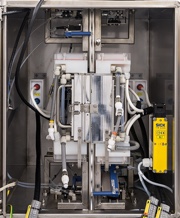Pulsed light technology has been researched as a sterilisation method for food packaging since the 1980s–1990s. Equipment producer Claranor has worked on the process for many years and has now developed a practical system that is being adopted by the food industry for filling lines running extended shelflife (ESL) products.
The first Claranor system for the internal and external sterilisation of flat caps was recently developed and implemented on a filling line for ESL fruit juices. The product in question is an orange juice without a preservative, that can be stored in the chilled chain for 10 weeks. It is filled in a PET bottle, closed with a flat-cap and aluminium foil.
The product needs treatment of the internal packaging parts in contact with the juice and also external cap sterilisation to avoid cross-contamination in the clean filling room.
Other methods that were considered failed to meet all the requirements. For example, cap sterilisation with chemicals could not be used because of the complex shape of the cap generating a trapping hazard in the dead volumes of the cap. A UVC solution was tried but did not reach the required log reduction during validation. The pulsed light solution developed by Claranor fulfilled all the customer’s requirements.

Optical cavities in production mode
The product in question is an orange juice without preservative, yet with a shelf-life of 70 days when stored chilled. It is packaged with a flat-cap with an aluminium foil seal. The line speed required is around 440 caps/min.
The pulsed light solution involves two reflector lamps: one for internal decontamination and one for external decontamination, designed specifically to the shape of the cap. The technology utilises short duration pulses of intense, broad-spectrum light, (rich in UV-C) generated by xenon lamps, for the sterilisation of the packaging surface. The cells are immediately killed due to a combined effect of high power flashes of light (1MW, during 0.3ms) and broad spectrum of UV. As a result, it produces up to a 5 log reduction of all germs, including spores.
Adaptable on high speed lines
The challenge was to keep up with the high speed of the line, which involved instant sterilising of internal and exterior sides. Designed to comply with the new requirement of sterilising the internal and external surfaces of the cap simultaneously, Claranor developed and patented the solution with two reflectors placed around the cap chute and installation of a second optical cavity.
The decontamination results achieved were beyond the customer’s expectations (see Table 1).
| Table 1 | |
| Internal | External |
| Two refector lamps | One reflector lamp |
| Treatment 2500V – one flash | Treatment 2500V – one flash |
| Log reduction of >4 on Bacillus atrophaeus SC 204-2 (customer reference germ) and Bacillus atrophaeus DSM 675 (Claranor reference germs) | Log reduction of >3.8 log on Bacillus atrophaeus SC 204-2 (customer reference germ) and Bacillus atrophaeus DSM 675 (Claranor reference germs) |
Recently, the company delivered a second machine with this ‘full decontamination’ configuration, this time to the dairy market for a low pH product – milk with an ESL of 90 days. The packaging comprises a white flat cap with aluminium foil, and the line runs at 100caps/min. Claranor’s solution was to provide one lamp for inside: 1 flash/cap, and two lamps for outside; 1 flash/cap, integrated above the capper. The sterilisation results for this systems are given in Table 2.
| Table 2 | |
| Internal | External |
| One lamp | Two lamps |
| Treatment 2500V – One flash | Treatment 2500V – One flash |
| Log reduction of >4.5 on Aspergillus brasiliensis DSM 1988 | Log reduction of >3.8 on on Aspergillus brasiliensis DSM 1988 |
Expertise in pulsed light
Claranor has been designing and manufacturing pulsed light packaging sterilisation equipment dedicated to the beverage and dairy industries since 2004. This sustainable and compact innovative technology offers a high level of decontamination, up to 5 log reduction of all germs, including spores. The reliable and cost effective solution avoids the need for chemicals on production lines.
The compactness of the equipment makes the solution easy to integrate on existing or new lines and a broad range of applications is already available, including for cups, buckets and lids for the dairy industry and caps and preform necks for the beverage sector. Other new applications are also under development and Claranor offers a custom fabrication service to meet customers’ requirements.




